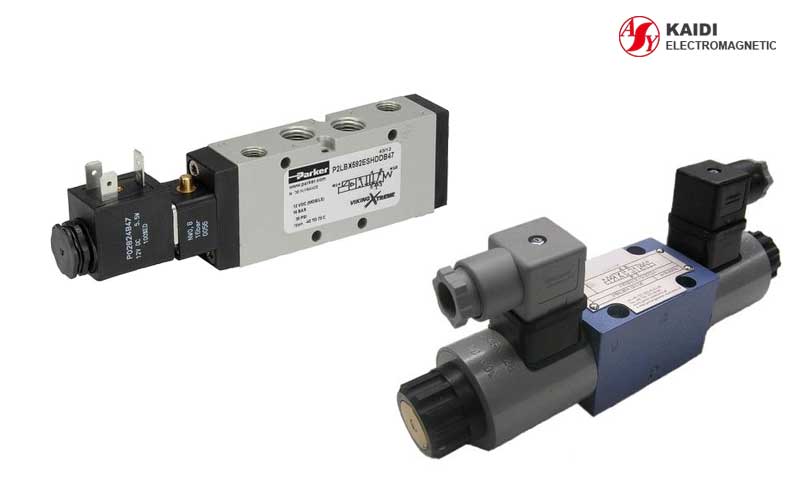Parker Solenoid Valve is a valve body with one or several holes, made up of solenoid coil and core. When the coil is power on or off, the operation of the core will cause the fluid to pass through the valve body or be cut off in order to change the direction of the fluid. The electromagnetic components of the solenoid valve consist of a fixed iron core, movable iron core, coil and so on. The valve body consists of the spool, slide valve sleeve, spring base and so on. The solenoid coil is installed directly on the valve body which is sealed in tube, forming a concise and compact combination. The valves that we often use in production are two position three-way valves, two positions four-way valve, and two positions five-way valve. Here the two positions mean charging or losing power for solenoid valve and it means on and off for the valve.
Working principle of Packer Solenoid Valve
The solenoid valve can be divided into three categories according to their working principle (direct-acting type, step-by-step acting type, pilot-type), and it can also be divided into six subcategories according to the difference on disc structure, material and working principle (direct motion diaphragm structure, step-by-step weight structure, pilot membrane structure, direct acting piston structure, step-by-step piston structure, pilot piston structure) .
Direct-acting solenoid valve
- Principle: When power is applied, the electromagnetic coil generates electromagnetic force to lift the closing member from the valve seat and the valve is opened. When the power is off, the electromagnetic force disappears, the spring pressure to close the valve seat, and the valve closed.
- Characteristic: It can work properly under vacuum, zero pressure and negative pressure, but the path is generally no more than 25mm.
Step by step direct-acting solenoid valve
- Principle: It combines the direct acting and pilot type. When there is no pressure difference between the inlet and outlet, and the power is turned on, the electromagnetic force lifts the pilot valve and the main valve closing member in order, then the valve is open. When the pressure difference between the inlet and outlet achieve the starting pressure difference, the pressure of solenoid pilot valve and the lower part of main valve rise so that the pressure difference can push the main valve upwards. When power is off, the pilot valve uses the spring force or the force of the medium to push the closing member to move downward, and the valve closes.
- Characteristic: it can work under zero pressure, vacuum, and high pressure, but the power is larger, requiring horizontal installation.
Pilot solenoid valve
- Principle: When power is on, the pilot force opens the pilot hole and the pressure in the upper chamber drops rapidly, causing a pressure drop across the closing member, and the fluid pressure forces the closure to move upwardly, then the valve opens. When the power is off, the spring force to close the pilot hole, the inlet pressure quickly through the bypass hole in the chamber around the closure of the formation of low pressure on the next high, and the fluid pressure forces the closure to move downwardly, then the valve closed.
- Characteristic: The upper limit of the fluid pressure is relatively high, so it can be installed anywhere (need to customize), but it must meet the Fluid pressure differential conditions.
The troubleshooting of Parker Solenoid Valve
The malfunction of solenoid valve will influence the action of switch valve and control valve directly. Common malfunction is that the solenoid valve does not move. It should be investigated from the following aspects:
- The solenoid valve not working when the power is on
- Check the power supply wire; Reconnect the connector and wire.
- Check whether the power supply voltage is in working range; Adjust to normal working range.
- Check whether the coil is disordering; reweld the coil.
- Coil short circuit; change coil.
- Check whether the pressure differential is proper; adjust the pressure differential or change the relevant solenoid valve.
- Fluid temperature is too high; change the relevant solenoid valve.
- Impurities make the main spool and moving the core of the solenoid valve stuck; clean them and change the seal and install the filter if the seal is broken.
- Liquid viscosity and the frequency is too high, and the service life is over, change the product.
- The solenoid valve cannot be closed
- The main spool or iron core seal has been damaged; change the seal; Check whether the liquid viscosity and temperature are too high; Replace the counterpart of the solenoid valve.
- Impurities flow into the solenoid valve spool or moving core, clean them.
- Spring has been deformed, change the spring.
- Orifice and balanced hole are blocked; clean them on time.
- Working frequency is too high or service life is over; change or update the product
- Other cases
- Internal leakage; check whether the seal is damaged and the spring assembles improperly.
- External leakage; the joint is loose or the seal has been damaged, tighten the screw or change the seal.
- There is noise when power is on; Firmware is loose, so tighten the firmware.
- Voltage fluctuations are not out of range; adjust the voltage.
- Core suction surface has impurities or is uneven, change or clean immediately.
As a leading solenoid supplier in China, Kaidi supply solenoid or solenoid coil for Parker, Rexroth, Yuken solenoid valve. We also provide customization service according to clients’ needs.
